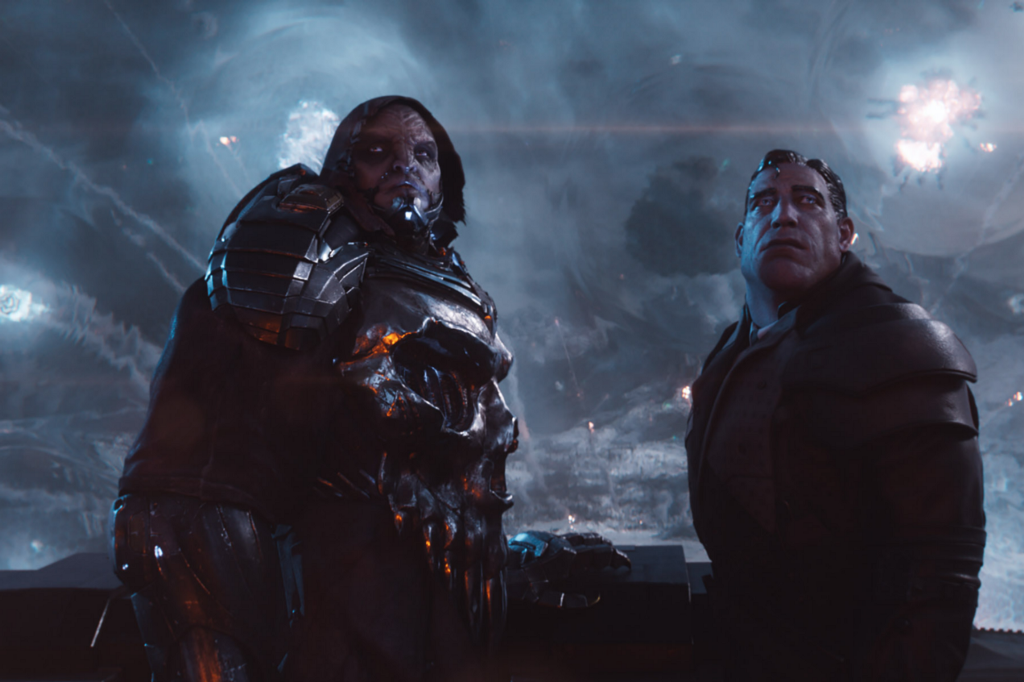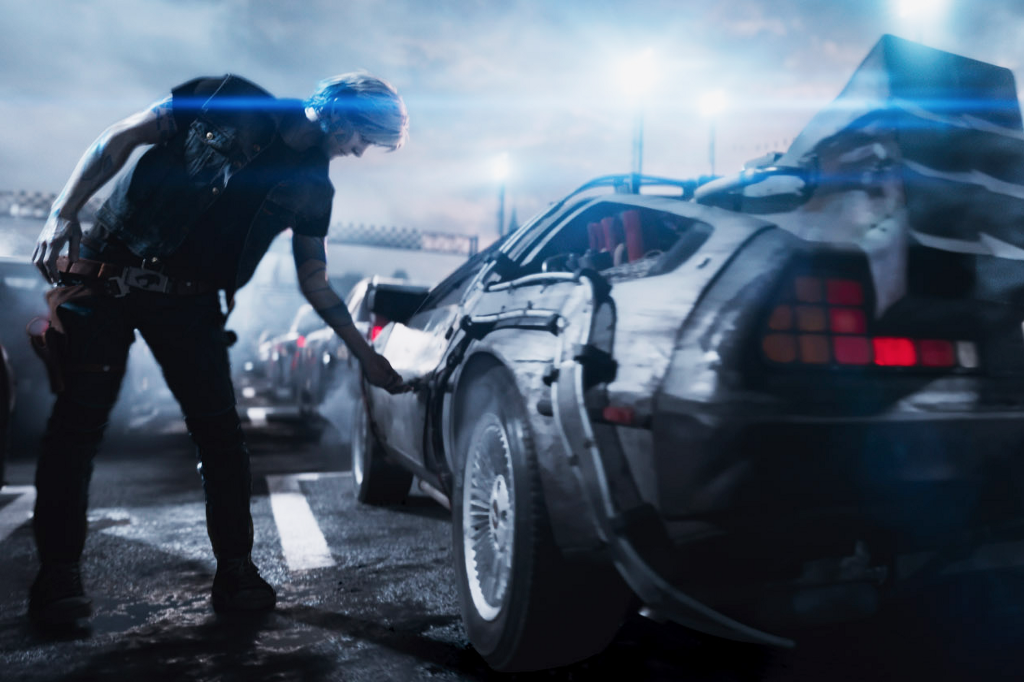You don’t need to see a movie about living in a future world of perpetual nostalgia — you’re already there now. At a time when the Roseanne reboot is the biggest thing on television, a bunch of major rock stars are doing huge farewell tours, Stranger Things is a Netflix staple and every other blockbuster is based on a comic book created decades ago, everything old is always new again.
The hook of Steven Spielberg’s Ready Player One, based on Ernest Cline’s 2011 novel, is that it satisfies our jones for a steady stream of pop-culture references: It takes place in 2045 and stars Tye Sheridan as Wade, a young man obsessed with the video games, movies, music and TV shows that you love, too. He’s less a person than an avatar, plugging into a virtual world where he can hang out with King Kong, Batman and the Iron Giant while driving Back to the Future’s souped-up DeLorean. In Ready Player One, this IP overload is meant to be nerd heaven. But for me, it felt like hell — and, deep down, I wonder if Spielberg intends it that way.
While it would be impossible to make the case that any one man created the pop-culture junkyard in which we now reside, the 71-year-old Oscar-winner is certainly one of its chief architects. It was his revolutionary 1975 movie Jaws that helped give birth to the Hollywood blockbuster, discovering that huge groups of people would see a film with a rollercoaster-like sense of thrills and chills. Along with George Lucas, the man behind Star Wars and the producer of the Indiana Jones movies, Spielberg understood that mainstream movies could be massive entertainment vehicles. Not surprisingly then, he delivered many of the films that defined the 1980s: Raiders of the Lost Ark, E.T., Poltergeist, Gremlins, The Goonies, Back to the Future and Who Framed Roger Rabbit chief among them.
For better or worse, Steven Spielberg is the 1980s. And so, Ready Player One can be read as both a celebration of the world he made and a dark reckoning with the side effects of our amused-to-death age.
In the film, Spielberg’s mixed feelings seem obvious from the start. As Ready Player One begins, we see only black and the comforting, familiar notes of Van Halen’s “Jump.” It’s a rousing, fun song that everybody knows and likes, presumably preparing us for the nostalgia blast that Ready Player One is going to be. Instead, we cut to a shot of a bleak, overcast, nondescript metropolis. This is the world of 2045, where there have been violent “bandwidth riots” and life has fallen into a semi-post-apocalyptic haze. Sure, Wade and his friends still have their pop-culture fixes, but what does it matter when real life is a miserable hellscape?
That opening shot sets the stage for everything that follows in Ready Player One, where people entertain themselves by indulging their nostalgia cravings at the expense of everything else. I realize there’s a reflexive pleasure in spotting beloved references in the movie — I smiled when artifacts from my favorite film, 2001, popped up — but the onslaught of visual shout-outs ends up feeling wearisome as opposed to exhilarating. All this collective love of the past — all this slavish idolization of old movies, old TV shows, old songs — is like a weight on the characters, keeping them from living their own lives and developing their own personalities. When Wade wants to impress a girl on a date, he dresses in Prince’s Purple Rain outfit. When they dance together, they move to “Stayin’ Alive” and mimic John Travolta’s Saturday Night Fever moves. Ready Player One is a nightmare of what happens when we’re just the sum total of the pop culture we’ve consumed.
“Nostalgia does not have eternal life,” Spielberg said in a recent interview. “I use nostalgia when I’m in a bad situation, when I’m feeling stressed or when the world is an ugly place to read about or to watch on television. I use nostalgia to escape.” That Spielberg has made Ready Player One is bittersweet. He’s built his legacy on these cultural totems that we now treat like religions. That sorta makes him God — but what a weird kingdom he’s created.
Here are a few other takeaways from Ready Player One. (And warning: There will be spoilers.)
#1. Why is T.J. Miller in this?
Ready Player One has a stellar cast, including up-and-comers (Sheridan and Olivia Cooke) and respected veterans (Ben Mendelsohn, Simon Pegg and Mark Rylance). Sadly, it also has T.J. Miller.
When the movie was filmed back in 2016 — it took about 18 months to finish all the effects — Miller was a rising star. He’d already begun building up an impressive résumé, getting roles in Yogi Bear and Get Him to the Greek while also doing voice work in the How to Train Your Dragon movies and Big Hero 6. Plus, he was a highlight of Deadpool and had a hit HBO sitcom in Silicon Valley.
So when Spielberg was looking for someone to play the comic relief in Ready Player One in the form of i-R0k, a wisecracking mercenary who assists the film’s chief villain (Mendelsohn), Miller made sense.

Because i-R0k is a virtual character, we never see the comedian. But you hear his voice. And whenever you do, it completely jolts you from the film. The reason is because of the Miller we’ve come to know in the last year or so. The one who burned every bridge at Silicon Valley and left the show. The one who was accused of sexually assaulting and punching a woman in college. The one who made obnoxious comments in interviews to be “edgy,” like when he pontificated about why women aren’t as funny as men. (“They’re taught to suppress their sense of humor during their formative years,” he explained to Vulture.) Never mind that he was in The Emoji Movie, which was probably 2017’s worst film: For a normal person, that alone would be a deal-breaker, but for Miller, it’s merely the six- or seventh-most offensive thing about him.
In her Ready Player One review, Vanity Fair critic Joanna Robinson pinpoints what’s so grating about hearing Miller in the film doing his wiseass shtick: “Miller has been largely absent from [publicizing] the film — but his voice work in the film serves as a constant reminder that the consequences of the #MeToo movement have not reached all men.”
I wonder if the producers were tempted to scrub him out completely and replace him with another voice actor. My guess is there might have been some contractual thing that kept that from happening. Still, Spielberg was an early #MeToo advocate, so it’s a bad look to have Miller in your big-budget movie.
#2. Spielberg is a great filmmaker. He is a terrible film-ender.
Spielberg has made plenty of classic movies. He would’ve made several more if he hadn’t botched their endings:
- Saving Private Ryan: Having Old Private Ryan at the graveyard at the end diminishes the power of everything that came before — especially Tom Hanks’ dying soldier telling Matt Damon to “earn this.”
- A.I.: Leaving David (Haley Joel Osment) at the bottom of the ocean would’ve been an incredible, dark ending. But the movie keeps going, adding a denouement where David is revived years later that isn’t nearly as affecting.
- Minority Report: This movie has several good endings: the really dark one (Tom Cruise gets locked away forever) and the really happy one (Tom Cruise solves the case). But Spielberg blows by them both to give us a flimsy, where-are-they-now? conclusion that feels anticlimactic after everything that’s happened.
- Lincoln: If you’re gonna make a movie about Abraham Lincoln, it basically has to end with his assassination. And Lincoln almost found a perfectly understated finale, with a hazy shot of Lincoln walking off into the distance, heading out to an evening at Ford’s Theatre and his tragic demise. But, of course, Spielberg couldn’t let it be — his poetic ending is abandoned for an on-the-nose resolution where everybody basically sits around and goes, “Oh, man, Abe got shot! He’s dead!”
Ready Player One is another of Spielberg’s multiple-ending movies. When Wade and his friends win the big contest and gain control of OASIS, which is the story’s mighty VR realm, that feels like the proper ending. But instead, Ready Player One just keeps going, tying up loose ends that, frankly, don’t need to be tied up.
Telling indelible stories is a gift. Knowing when to draw the curtain is equally important.
#3. Now is a good time to watch the ultimate ‘Shining’ fan-geek documentary.
Most of Ready Player One’s 1980s shout-outs are blink-and-you’ll-miss-them experiences. But the film takes an extended, inspired trip into the Overlook Hotel, the unnerving setting for The Shining, as the characters wander around the building and stumble upon several of the iconic scenes from the Stanley Kubrick horror movie. It’s film-geek nirvana.
The sequence reminded me of the brilliant under-seen 2012 documentary Room 237, which brings together several of the craziest and most intense fan theories about The Shining that have developed since the film premiered in 1980.
In it, director Rodney Ascher puts voiceover from these theorists on top of images from The Shining, and the more they talk, the more eerily plausible some of their ludicrous readings of the film become. Did Kubrick really make the movie to admit to helping the U.S. fake the moon landing? Is The Shining actually about America’s slaughter of its indigenous people? Or is it about the Holocaust?
Room 237 is an intelligent, excellent illustration of how fan-geek obsession can be seductive but also open a door to insanity.
#4. Here’s some 1980s stuff not referenced in ‘Ready Player One.’
It’s not a complete list, but it’s close:
- The Replacements
- Teddy Ruxpin
- Spitting Image
- St. Louis Cardinals All-Star second baseman Tommy Herr
- That one episode of Cheers where Ted Danson rapped
- Garfield
- Graceland
- Gobots
- New Coke
- Trivial Pursuit
- All the lyrics to R.E.M.’s “It’s the End of the World as We Know It (And I Feel Fine)”
- Spy magazine
- The brief movie career of Yahoo Serious

